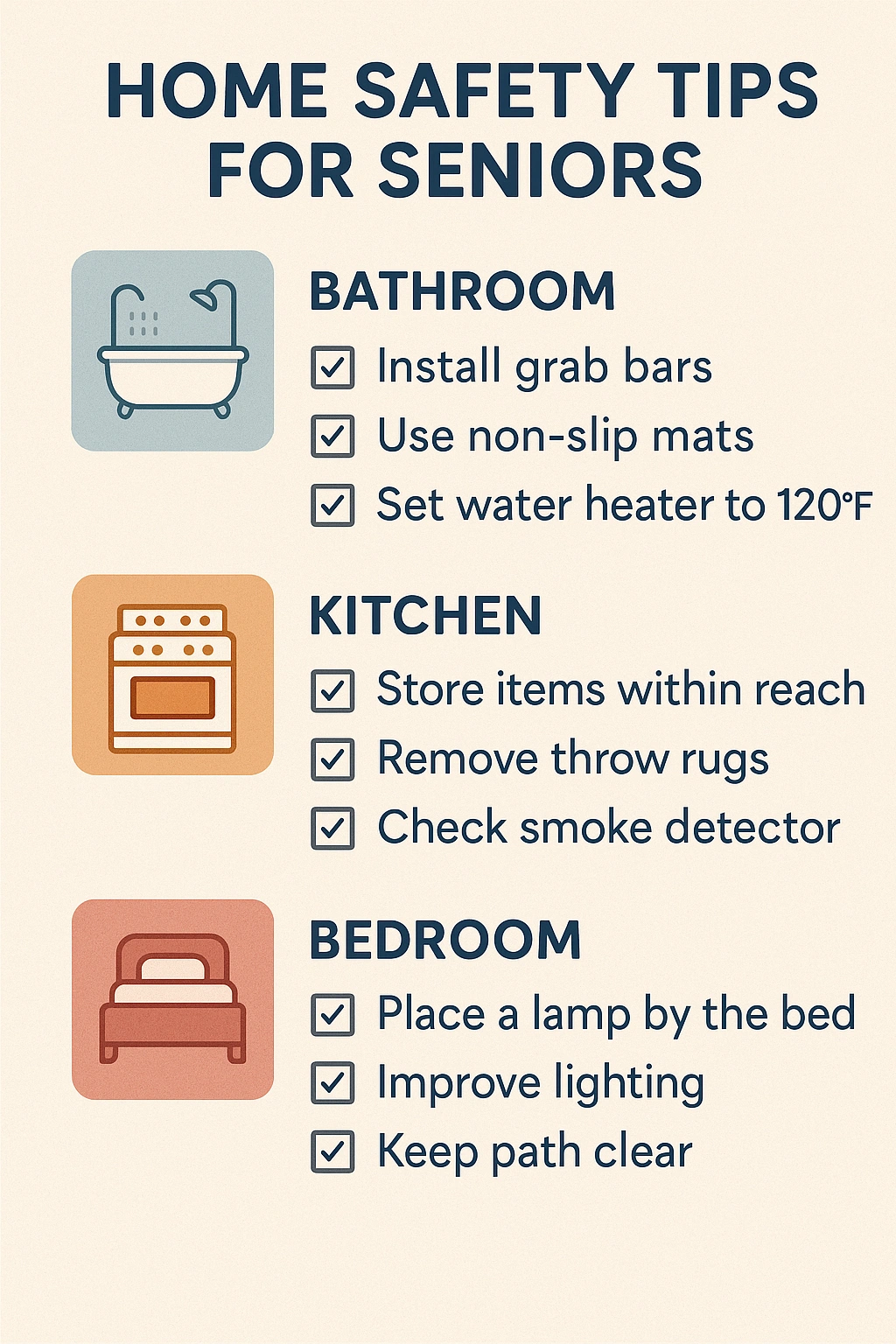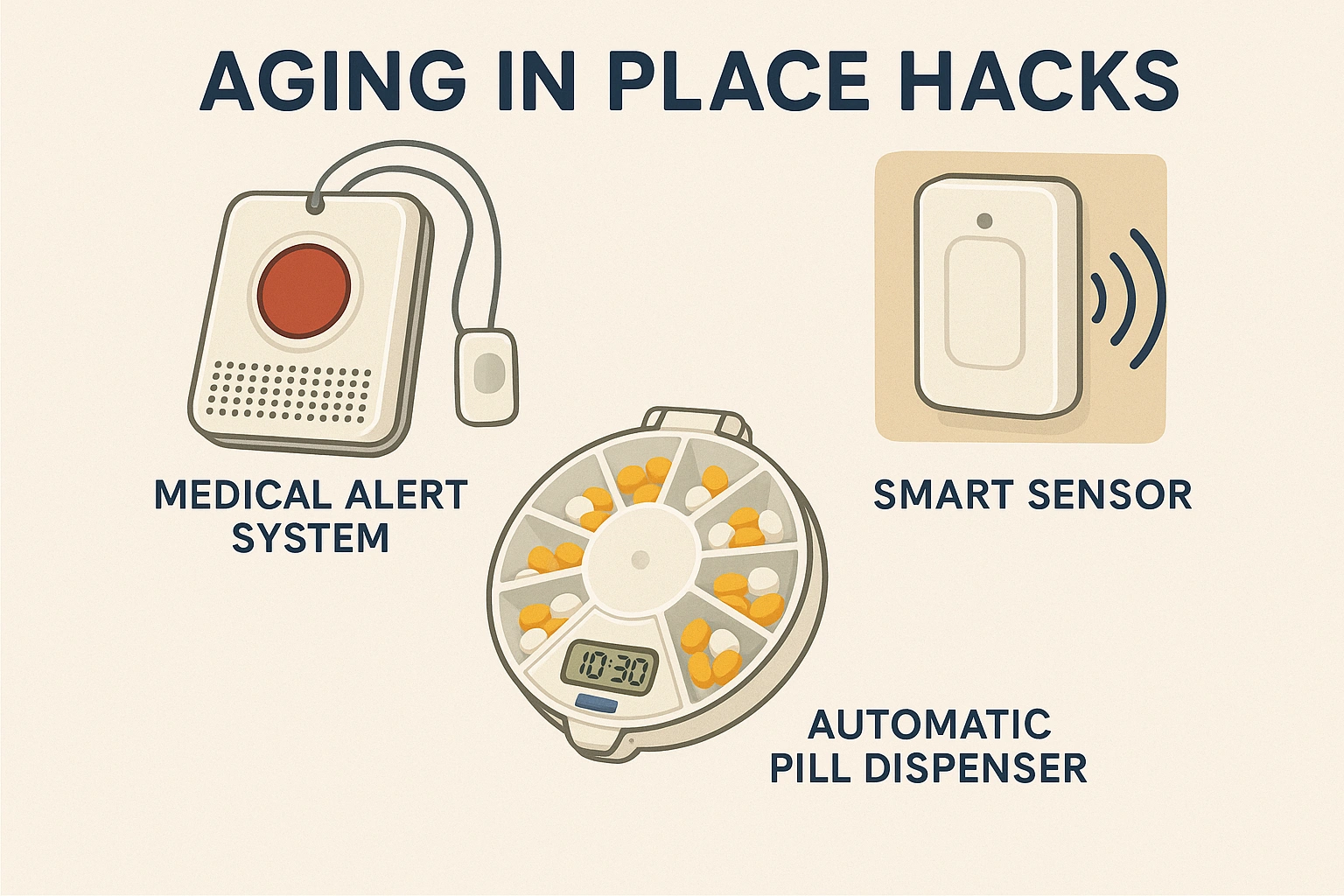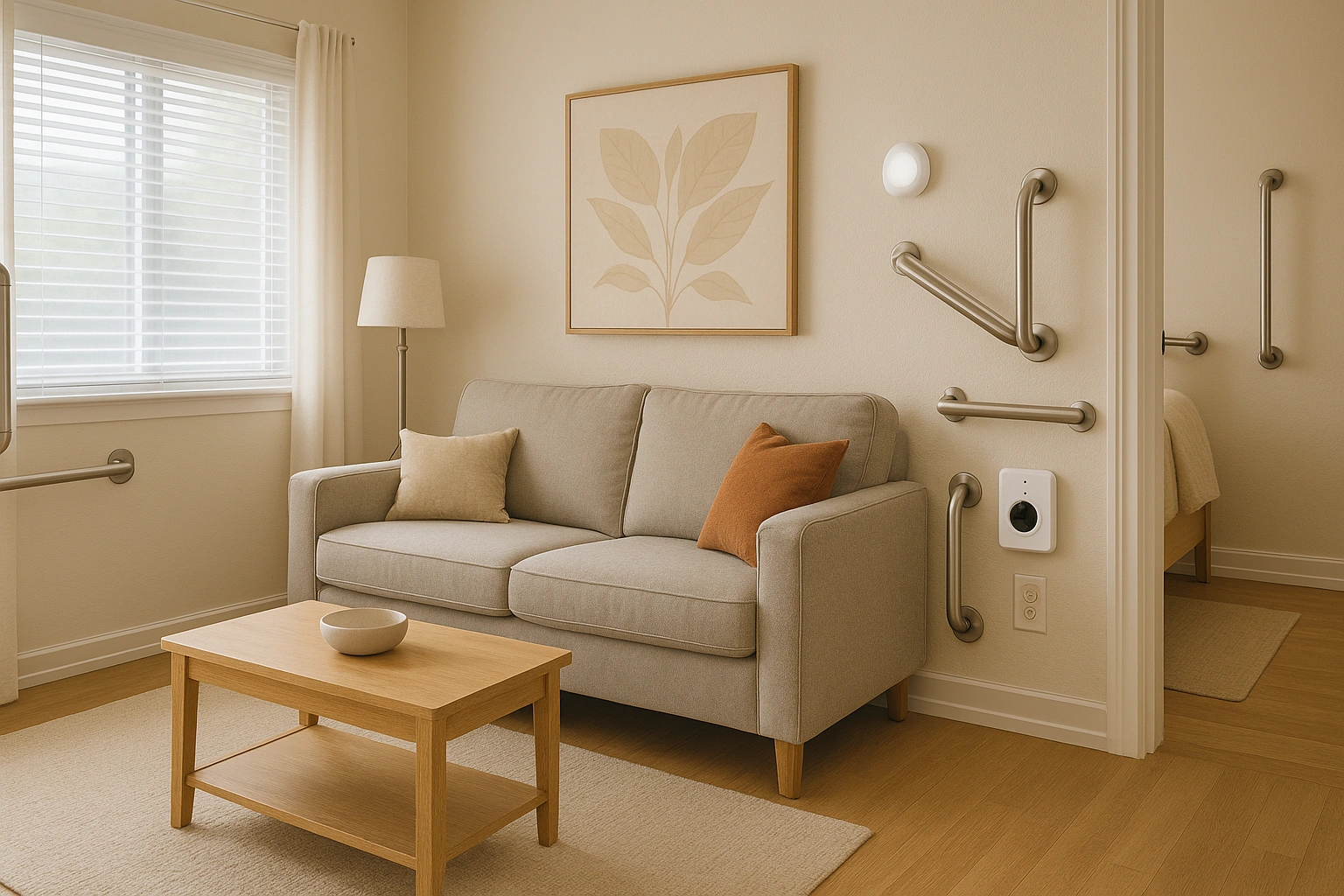The Invisible Hazard in Plain Sight
Did you know that every year, one in four older Americans will fall? For many, that fall happens at home, making home safety tips seniors essential for preventing injuries. Simple hazards like loose rugs or poorly lit hallways can be addressed by following home safety tips seniors, reducing risk and promoting independence. By incorporating practical home safety tips seniors, you empower your loved one to navigate their space confidently and safely. This guide uses room-by-room strategies informed by home safety tips seniors to create a secure and comfortable home for aging in place.
What is Home Safety Tips Seniors? A Holistic View
As highlighted by the Centers for Disease Control and Prevention (CDC), falls are the leading cause of fatal and nonfatal injuries among older adults. The future of home safety is moving towards proactive, technology-driven solutions—smart sensors that detect falls, automated medication dispensers, and telehealth services that allow for remote monitoring. It’s about blending simple physical modifications with smart technology to create layers of protection.

Why Prioritizing Home Safety is a Game-Changer
Taking a proactive approach to home safety yields profound benefits for both seniors and their families.
Promoting Independence and Confidence
When seniors feel secure in their environment, their confidence soars. They are more likely to stay physically active and socially engaged. Simple modifications, often called **aging in place hacks**, remove the fear of falling, allowing them to navigate their home freely and maintain their cherished routines and independence for longer.
Preventing Costly Accidents and Hospitalizations
A fall can trigger a devastating domino effect: a hospital stay, surgery, a lengthy rehabilitation, and a potential move to a long-term care facility. The financial and emotional costs are immense. By investing a small amount in safety measures upfront—like grab bars and better lighting—you can prevent life-altering accidents and their catastrophic expenses.
Providing Peace of Mind for Families
For adult children living miles away, the worry can be constant. Knowing that your parent’s home has been systematically made safer provides incredible peace of mind. It transforms anxious phone calls into positive conversations, allowing you to focus on quality time rather than constant safety concerns.
Just as a farmer must implement a detailed strategy for the physical safety of their animals, families must create a comprehensive plan for their aging loved ones. A safe environment is the foundation for health and well-being. For insights into detailed planning in other fields, you can review resources like this guide on farm management.
The Room-by-Room Home Safety Audit
Use this checklist to systematically evaluate every area of the home for potential hazards.
The Bathroom: Ground Zero for Falls
- Install Grab Bars: Place them inside and outside the tub/shower and next to the toilet. Do not use suction cup bars; they are unreliable.
- Use Non-Slip Surfaces: Apply non-slip decals in the tub and use a rubber-backed, non-slip mat on the floor.
- Improve Access: A raised toilet seat and a sturdy shower chair can make a world of difference.
- Ensure Good Lighting: A bright vanity light and a waterproof light inside the shower are essential.
The Kitchen: Balancing Independence and Safety
- Prevent Fires: Keep a fire extinguisher handy. Consider an automatic stove shut-off device that turns off burners if left unattended.
- Improve Accessibility: Move frequently used items to lower, easy-to-reach shelves to avoid the use of step stools.
- Check Temperatures: Set the hot water heater to 120°F (49°C) or lower to prevent scalding burns.
Bedrooms and Hallways: The Path to Safety
- Clear the Pathways: Remove clutter, electrical cords, and small furniture from all walking areas.
- Secure Rugs: Remove throw rugs entirely or secure them firmly with double-sided tape.
- Light the Way: Install motion-sensing night lights in the hallway between the bedroom and bathroom.
- Ensure Bedside Access: Place a lamp, phone, and flashlight within easy reach of the bed.

Real-Life Story: Maria’s Independence Makeover
“My mom, Maria, is fiercely independent, but after a close call where she slipped in the bathroom, we knew we had to act. We didn’t want to change her home; we wanted to enhance it. We spent one weekend focused on home safety tips for seniors.”
“We installed sturdy grab bars and a shower chair, replaced her dim hallway bulbs with bright LEDs, and taped down the edges of her area rugs. The biggest game-changer was a medical alert pendant. She was hesitant at first, but now she calls it her ‘independence necklace.’ She feels safer, and we have peace of mind. It wasn’t about limiting her; it was about securing her freedom.”
Comparison of Safety Technologies
Modern technology offers powerful new layers of safety for seniors living alone.
| Safety Solution | Key Features | Pros | Cons |
|---|---|---|---|
| Medical Alert System | Wearable button, 24/7 monitoring, optional fall detection. | Immediate access to help, reliable, provides peace of mind. | Monthly fee, potential stigma (feeling “old”). |
| Smart Home Sensors | Motion, door, and bed sensors that learn patterns. | Discreet, no wearables, can alert family to unusual activity. | Higher upfront cost, doesn’t provide direct emergency help. |
| Automated Medication Dispenser | Locks pills and dispenses them at pre-set times with alarms. | Prevents medication errors and overdoses, reduces confusion. | Requires setup, monthly fees for advanced models. |

7 Common Safety Mistakes to Avoid
Even with good intentions, overlooking simple details can compromise safety, making home safety tips seniors essential. Ignoring expert guidance from home safety tips seniors may lead to preventable accidents. By regularly reviewing and applying home safety tips seniors, you ensure a secure environment for your loved one. Staying proactive with home safety tips seniors helps maintain independence, confidence, and peace of mind at home.
- Using the Wrong Equipment: A towel rack is not a grab bar. Suction-cup safety handles are not a substitute for professionally installed, screw-in bars.
Fix: Invest in durable, professionally rated safety equipment. It’s designed to hold a person’s full body weight in a fall.
- Ignoring Poor Lighting: Vision declines with age. Dimly lit rooms, especially stairs and hallways, are a major hazard.
Fix: Increase bulb wattage (use bright LEDs), add lamps to dark corners, and use night lights generously.
- Forgetting Fire Safety: An older adult may not hear a standard smoke alarm or be able to escape quickly.
Fix: Test smoke detectors monthly. Install alarms with flashing lights and vibration alerts for the hearing impaired. Ensure a clear escape path.
- Keeping Medications Disorganized: A jumble of pill bottles can easily lead to a dangerous mix-up.
Fix: Use a labeled pill organizer or an automated dispenser. Keep an updated list of all medications and dosages on the fridge.
- “It’s Always Been Like That”: Resistance to change is common. The argument that a loose rug or cluttered hallway “has been fine for years” ignores changing mobility and balance.
Fix: Frame the changes in terms of preserving independence, not taking it away. Explain that these modifications help ensure they can stay in their home longer.
- Overlooking Emergency Preparedness: What happens if the power goes out? Is there a plan?
Fix: Create an emergency kit with flashlights, batteries, a radio, and water. Post emergency contact numbers in large print on the refrigerator.
Expert Tips for a Safer Home
Go beyond the basics by exploring expert home safety tips seniors that address common hazards. Implementing home safety tips seniors ensures your loved one can move confidently and reduce the risk of accidents. By following detailed home safety tips seniors, families can create a secure environment without sacrificing comfort. Thoughtful planning with home safety tips seniors helps seniors maintain independence while staying safe at home.
- Consult an Occupational Therapist (OT): “An OT can perform a professional home safety assessment tailored to your loved one’s specific medical conditions and mobility challenges,” says a certified aging-in-place specialist. “They see hazards that families often miss.”
- Adopt the “One-Touch” Rule: Place essential items where they can be reached easily from a seated position to minimize unnecessary trips and reduce fall risk.
- Secure Furniture: Ensure that any furniture a senior might use to steady themselves—like a bookshelf or dresser—is securely anchored to the wall.
- Perform Regular “Sweeps”: Once a week, do a quick walkthrough of the main living areas to check for new clutter, curled rug edges, or burnt-out lightbulbs.
Frequently Asked Questions (FAQ)
What is the single most important safety modification for a senior’s home?
While it varies by individual need, the most impactful modification is often improving the bathroom. This includes installing grab bars in the shower and next to the toilet, using a non-slip bath mat, and adding a shower chair. The bathroom is where a high percentage of serious falls occur, making it the top priority for safety upgrades.
How can I make a home safer for a senior with dementia?
For dementia, safety also involves preventing wandering and confusion. Use door and window alarms, install automatic stove shut-off devices, and reduce clutter to create clear pathways. Labeling cabinets and drawers with pictures or simple words can also help reduce frustration and improve their ability to navigate their own home.
Are medical alert systems still relevant with smartwatches?
Yes, very much so. While some smartwatches have fall detection, dedicated medical alert systems offer 24/7 monitoring by trained professionals who can dispatch emergency services and contact family. They are often more reliable in a crisis, are designed specifically for emergency use, and many are waterproof for use in the shower, where phones and watches are rarely taken.
What’s an inexpensive way to improve lighting for a senior?
One of the easiest and most affordable fixes is to install plug-in, motion-activated night lights in hallways, bedrooms, and bathrooms. They provide instant, hands-free illumination for nighttime trips, drastically reducing the risk of falls in the dark. Upgrading to higher-wattage, brighter LED bulbs in main fixtures is another low-cost, high-impact change.
How often should a home safety audit be performed?
A thorough audit should be done at least once a year. However, it’s also crucial to reassess safety after any significant health event, such as a fall, a new diagnosis, a hospitalization, or if the senior starts using a new mobility aid like a walker or cane. Their needs change, and their environment must adapt accordingly.
Conclusion: Safety as the Ultimate Act of Love
Creating a safe home environment is one of the most practical ways to show you care, and following home safety tips seniors can significantly reduce risks. Implementing home safety tips seniors throughout the house helps prevent accidents and supports independence. By considering simple changes guided by home safety tips seniors, you can enhance confidence and comfort for your loved one. Thoughtful attention to detail, informed by home safety tips seniors, ensures they can enjoy a full and vibrant life safely in their own home.
The process doesn’t have to be overwhelming. Start with the highest-risk areas, like the bathroom, and make gradual changes. The goal is progress, not perfection. For more resources and checklists, organizations like the National Council on Aging (NCOA) offer excellent, in-depth information to guide you on your journey.
